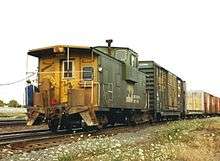Crow's nest
A crow's nest is a structure in the upper part of the main mast of a ship or a structure that is used as a lookout point.

This position ensured the best view for lookouts to spot approaching hazards, other ships, or land by naked eye or use of a monocular. It was the best device for this purpose until the invention of radar.
It should not be confused with the top, the platform in the upper part of each lower mast of a square-rigged sailing ship.
According to William Scoresby Jr., the crow's nest was invented in the 19th century by his father, William Scoresby Sr., a whaler and also an Arctic explorer.[1] However, Scoresby Sr. may simply have made an improvement on existing designs,[2] and depictions of older ships show similar structures.
The first recorded appearance of the term was in 1807, used to describe Scoresby Sr.'s barrel crows nest platform. According to a popular naval legend, the term derives from the practice of Viking sailors, who carried crows or ravens in a cage secured to the top of the mast. In cases of poor visibility, a crow was released, and the navigator plotted a course corresponding to the bird's flight path because the crow invariably headed towards the nearest land.[3] However, other naval scholars have found no evidence of the masthead crow cage and suggest the name was coined because Scoresby's lookout platform resembled a crow's nest in a tree.[4]
Since the crow's nest is a point far away from the ship's centre of mass, rotational movement of the ship is amplified and could lead to severe seasickness, even in accustomed sailors. Therefore, being sent to the crow's nest was also considered a punishment.
Other uses
Sometimes, the term is used metaphorically in reference to topmost structures in buildings, towers, etc.

In classic railroad trains, the box-like structure above the caboose, the cupola, was also called the crow's nest. It served for observation of the whole train when in motion.[5]
In hunting, a crow's nest is a blind-like structure where a hunter or a pair of hunters commit themselves to stalking game. A crow's nest is not a normal type of purchasable blind, but an improvised position, built by using locally discovered natural flora (tree branches, moss, snow (during winter) or sand (during summer), etc.). A crow's nest works in most environments and provides a good lookout point (hence the name) when built in an elevated position like a hillside or top of a hill.
References
- Scoresby, William (1828). Journal of a voyage to the northern whale-fishery; including researches and discoveries on the eastern coast of West Greenland, made in the summer of 1822, in the ship Baffin of Liverpool. A. Constable and Company. p. 470.
- Gillies, Robert Pearse (1826). Tales of a Voyager to the Arctic Ocean, Volume 2. H. Colburn. p. 11.
- navy.mil
- Joan Druett, "Crows Nest", World of the Written World, February 13, 2011
- "A Brief History of the Train". Archived from the original on 25 July 2010.
External links

_p184_I_SCORESBYS_TUNNA.jpg)